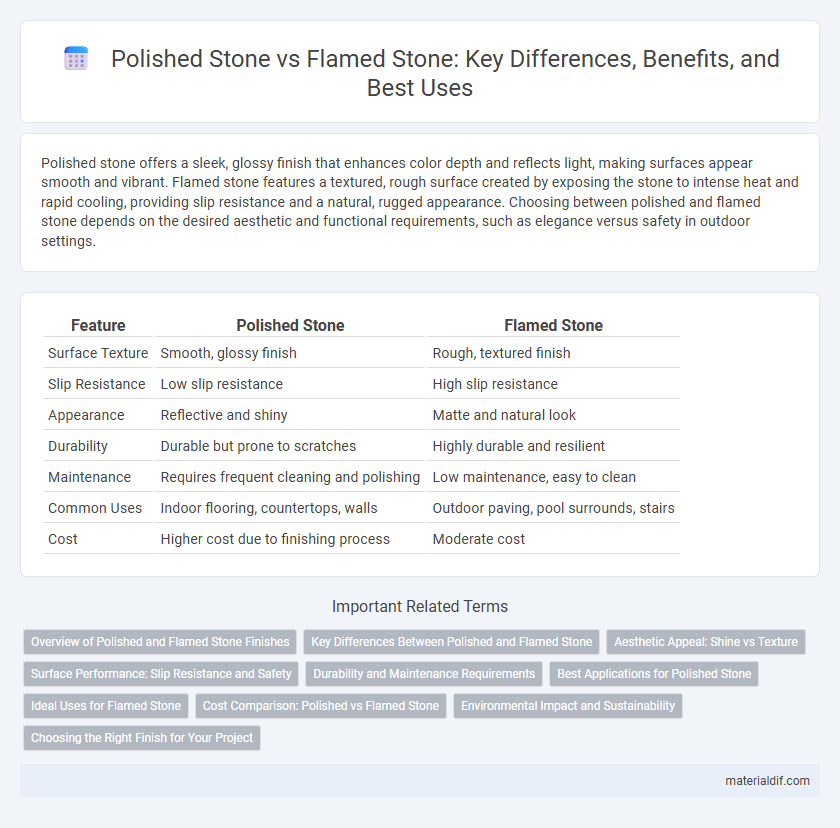Polished stone offers a sleek, glossy finish that enhances color depth and reflects light, making surfaces appear smooth and vibrant. Flamed stone features a textured, rough surface created by exposing the stone to intense heat and rapid cooling, providing slip resistance and a natural, rugged appearance. Choosing between polished and flamed stone depends on the desired aesthetic and functional requirements, such as elegance versus safety in outdoor settings.
Table of Comparison
| Feature | Polished Stone | Flamed Stone |
|---|---|---|
| Surface Texture | Smooth, glossy finish | Rough, textured finish |
| Slip Resistance | Low slip resistance | High slip resistance |
| Appearance | Reflective and shiny | Matte and natural look |
| Durability | Durable but prone to scratches | Highly durable and resilient |
| Maintenance | Requires frequent cleaning and polishing | Low maintenance, easy to clean |
| Common Uses | Indoor flooring, countertops, walls | Outdoor paving, pool surrounds, stairs |
| Cost | Higher cost due to finishing process | Moderate cost |
Overview of Polished and Flamed Stone Finishes
Polished stone finishes create a smooth, reflective surface by grinding and buffing, enhancing the natural color and pattern of the stone while offering a sleek, elegant appearance often used in interior applications. Flamed stone finishes are achieved by exposing the stone surface to intense heat, causing it to burst and form a rough, textured finish ideal for exterior use due to its slip-resistant properties. Both finishes highlight the stone's natural beauty but serve different functional needs, with polished focusing on aesthetics and flamed on safety and durability.
Key Differences Between Polished and Flamed Stone
Polished stone features a smooth, glossy surface achieved through mechanical grinding and buffing, enhancing its aesthetic appeal and reflecting light effectively. Flamed stone undergoes a high-temperature treatment that creates a rough, textured surface with increased slip resistance, making it ideal for outdoor and wet areas. The key differences lie in their finish, durability under different conditions, and suitability for specific applications like indoor flooring for polished stone versus exterior paving for flamed stone.
Aesthetic Appeal: Shine vs Texture
Polished stone boasts a high-gloss, reflective surface that enhances color depth and visual brightness, making it ideal for elegant and modern interiors. Flamed stone offers a rough, textured finish with a matte appearance, emphasizing natural grain and providing a slip-resistant surface perfect for outdoor use. The choice between polished and flamed stone depends on whether the desired aesthetic prioritizes shine and sleekness or rugged texture and durability.
Surface Performance: Slip Resistance and Safety
Polished stone offers a smooth, glossy surface that enhances aesthetic appeal but can be slippery when wet, posing safety concerns in high-traffic or wet areas. Flamed stone features a textured, rough surface created by exposing the stone to high heat, significantly increasing slip resistance and making it ideal for outdoor and wet environments. Selecting flamed stone improves safety by reducing slip hazards, while polished stone suits interior spaces where traction is less critical.
Durability and Maintenance Requirements
Polished stone surfaces offer a sleek, glossy finish that enhances color depth but require regular sealing and careful cleaning to maintain their shine and resist scratches. Flamed stone provides a rough, textured surface that is highly durable and slip-resistant, making it low-maintenance and ideal for outdoor applications. Both finishes retain the inherent strength of natural stone, but flamed stone is generally better suited for high-traffic areas due to its superior resistance to wear and weathering.
Best Applications for Polished Stone
Polished stone is ideal for interior applications such as flooring, countertops, and wall cladding due to its reflective surface and smooth finish that enhances natural color and veining. This stone finish is perfect for high-traffic areas like hotel lobbies and residential kitchens, where durability and aesthetic appeal are essential. It also performs well in commercial spaces requiring a sleek, elegant appearance combined with easy maintenance.
Ideal Uses for Flamed Stone
Flamed stone features a rough, textured surface created by exposing the stone to high-temperature flames, making it ideal for outdoor applications requiring slip resistance, such as walkways, patios, and pool surrounds. Its durability and natural traction perform well in wet conditions, enhancing safety in gardens and commercial landscaping. Flamed stone's rugged aesthetic complements rustic and natural design themes while maintaining strong resistance to weathering and wear.
Cost Comparison: Polished vs Flamed Stone
Polished stone typically incurs higher costs due to the labor-intensive grinding and polishing processes that enhance its smooth, glossy finish, making it ideal for high-end interior applications. Flamed stone involves a heat treatment that creates a textured, slip-resistant surface, generally resulting in lower production expenses and reduced overall pricing compared to polished finishes. When comparing costs, polished stone demands a premium price driven by aesthetic appeal and labor, whereas flamed stone offers an economical alternative suited for outdoor and high-traffic areas.
Environmental Impact and Sustainability
Polished stone surfaces require extensive water and chemical use during the finishing process, leading to higher environmental footprints compared to flamed stone, which relies on rapid heating and cooling without additional substances. Flamed stone offers greater durability and slip resistance, reducing the need for frequent replacements and thus promoting sustainability through longevity. Choosing flamed stone minimizes waste and energy consumption, aligning better with environmentally conscious construction practices.
Choosing the Right Finish for Your Project
Polished stone offers a glossy, reflective surface that enhances color depth and is ideal for interior applications requiring elegance and smoothness. Flamed stone provides a rough, non-slip texture perfect for outdoor spaces or areas prone to moisture, ensuring safety and durability. Selecting the right finish depends on the project's aesthetic goals, functional needs, and environmental exposure.
Polished Stone vs Flamed Stone Infographic

 materialdif.com
materialdif.com